




Performance analysis of the events groups as a predictor of high-level decathletes
Juan Alfonso García-Roca, Juan Manuel García-Manso, Juan Pedro Fuentes-García, María José Martínez Patiño
Performance analysis of the events groups as a predictor of high-level decathletes
Cultura, Ciencia y Deporte, vol. 17, no. 52, 2022
Universidad Católica San Antonio de Murcia
Juan Alfonso García-Roca * jagarcia@ucam.edu
Universidad Católica de Murcia, España
Juan Manuel García-Manso
Universidad de las Palmas de Gran Canaria, España
Juan Pedro Fuentes-García
Universidad de Extremadura, España
María José Martínez Patiño
Universidad de Vigo, España
Received: 27 july 2021
Accepted: 27 march 2022
Abstract: The objective of this study was to determine the structure of the decathlon and the value of each of the events an athlete must perform to complete this sports discipline, as well as to determine in which manner these events are grouped in Top-Level athletes with the aim to optimize the methodology of training and improve the selection of talents in the combined events. The sample utilized (102 performances in decathlon event) included the best all-time world specialists until July 2020, and with records equaling or higher than 8300 points (level to achieve the position of Olympic finalist). To establish the adequate grouping of events, a cluster analysis using the existing Euclidean proximity matrix between the different disciplines was utilized. Also, the relative weight (RW) of each discipline was used on the rest of the events and the resulting groupings. The results showed that five clearly-differentiated groups appeared in the decathlon: Group 1: 100 meters, 400 meters, 110 meters Hurdles, Long Jump and Pole Vault (RW= 53.8%); Group 2: High Jump (RW= 9.7%); Group 3: Shot Put and Discus Throw (RW=18.6%) Group 4: Javelin Throw (RW=9.2%) and Group 5. 1500 meters (RW=8.4%). The study proposes that discovering and precisely determining the groups of events in a decathlon allows the possibility to apply efficient principles to optimize the training process in this athletic event.
Keywords: combined events, athletic performance, cluster grouping.
Resumen: El objetivo de este estudio fue determinar la estructura del decatlón y el valor de cada uno de las pruebas que un deportista debe realizar para completar esta disciplina deportiva, así como determinar de qué manera se agrupan estas pruebas en deportistas de alto nivel con el objetivo de optimizar la metodología de entrenamiento y mejorar la selección de talentos en las pruebas combinadas. La muestra utilizada incluyó a los mejores especialistas mundiales de todos los tiempos hasta julio de 2020, y con registros iguales o superiores a 8300 puntos (nivel para alcanzar la posición de finalista olímpico). Para establecer la agrupación adecuada de las pruebas, se utilizó un análisis de conglomerados utilizando la matriz de proximidad euclidiana existente entre las diferentes disciplinas. Asimismo, se utilizó el peso relativo (RW) de cada disciplina en el resto de los eventos y las agrupaciones resultantes. Los resultados mostraron que en el decatlón aparecieron cinco grupos claramente diferenciados: Grupo 1: 100 metros, 400 metros, 110 metros vallas, salto de longitud y salto con pértiga (RW= 53,8%); Grupo 2: salto de altura (RW= 9,7%); Grupo 3: lanzamiento de peso y lanzamiento de disco (RW=18,6%) Grupo 4: lanzamiento de jabalina (RW=9,2%) y Grupo 5. 1500 metros (RW=8,4%). Descubrir y determinar con precisión los grupos de pruebas en un decatlón permite aplicar principios eficientes para optimizar el proceso de entrenamiento en este tipo de competición deportiva.
Palabras clave: pruebas combinadas, rendimiento en atletismo, agrupación clúster.
Introduction
Decathlon was included in the Summer Olympic Games calendar celebrated in Stockholm (Sweden) in 1912. The organizing committee of the V Olympic Games (Stockholm – Sweden) proposed, in 1910, the addition of the decathlon to the official program with a similar format to the current one. The decathlon, which took place in three days (100m, long-jump, shot-put, high-jump, 400m, 110m hurdles, discus, pole vault, javelin and 1500m). The present sequence with which the ten events should be celebrated and their duration (two days), was approved at the International Association of Athletics Federations Congress celebrated in 1914, without structural changes until the present (Trkal, 2003).
The decathlon encompasses four runs (100, 400, 1500 meters and 110 meters with hurdles) three jumps (long jump, high jump and pole vault), and three throws (shot put, discus and javelin throws). The competition takes place in two consecutive days since 1914, upholding the previously-established order that is still maintained up to today: Day 1: 100m, Long-jump (LJ), Shot put (SP), high-jump (HJ), and 400m; Day 2: 110m with hurdles, Discus Throw (DT), Pole Vault (PV), javelin throw (JT) and 1500m run (Competition & Technical Rules - IAAF, 2020). The performances of the athletes are recorded in units of distance and time, which are transformed into a previously-established score. Each event is scored according to the Scoring Tables developed and regulated by the IAAF for this athletic specialty (IAAF Scoring Tables for Combined Events). The winner of the decathlon is the athlete who has received the maximum number of points in the total score of all the ten events. On the performance factors in combined events and more specifically in the Decathlon, it has been studied and researched from the description and analysis of the conditional requirements in anthropometry (Bazyler et al., 2017), physical capacities (Garcia-Roca, 2021; Higgins, 1989; Tidow, 2000 a, Tidow, 2000 b, Tidow, 2001) or coordinative (Dziadek et al. 2018), of the factors that influence training (Kunz, 1989; Vana, 2003) and competition (Beaulieu, 1995; Duran & Beaume, 2006 ), but the most decisive factor in the study and research is the performance of the decathletes score, this knowledge and study of the current IAAF tables allows to establish up to three profiles of decathlon athletes: runners-jumpers (without 1500 m), runner-throwers and jumper-throwers in order for points achieve in these specialties (Etcheverry, 1995). These profiles have been statistically analyzed globally, taking into account the results of the world championships in the search for a balance between the scores of each event in the 90s. (Cox & Dunn, 2002), in the best Decathlon athletes (Pavlović & Idrizović, 2017) and with taxonomies or classifications (Bilic, 2015; Broáni et al., 2020). The Scoring Tables have been utilized since the XIX century (1884 – USA), although the Tables have not always been the same, and not all have been officially recognized. The main ones have evolved with different methodology strategies (linear, progressive and regressive (Trkal, 2003)). However, the manner in which to convert the results into points in an objective and equal manner has always been difficult to attain and a controversial subject, and a frequent reason for discussion and analysis (Chèze, 2018; Cox & Dun, 2002; Pavlović, 2017; Tidow, 2000 b; Westera, 2006). The first ones that were officially recognized were proposed by the Olympic Games (OG) Organization Committeein Stockholm-1912. The official tables were developed by the IAAF and modified in different periods (1934, 1950/52, 1962) until 1984 which is the current internationally recognized table.
Although the different updates have improved the scoring system, they are still not equilibrated with respect to the weight of each event on the final result of the decathlon (Westera, 2006). One of the most interesting aspects of these tables is that a detailed study of the score obtained by an athlete (or group of athletes), could be a useful tool for characterizing and identifying these specialists, and that, at the same time, for establishing the relative weight (RW) of each discipline or group of disciplines on the final result of this very complex athletic event. Knowing the events that have the greatest weight on the final result, and establishing the group of events with similar characteristics, could provide a significant advantage to coaches and researchers to detect and/or select potential specialists in combined events, as well as to develop training strategies that promote and optimize the work (Jiménez-Reyes & González-Badillo, 2011) of athletes and coaches because the different types of load should be managed by the trainers who differentiating between technical and conditional factors (Kunz, 1989). The decathlon training is an example of a complex interaction between the time used in practice and fit the different event and the performance, it's necessary establishment of the management in practice time in each day or session assisted for the knowledge of the groups of events that, until this moment, has not been studied.
The objective of this work is to determine the structure and the value of the disciplines that comprise the decathlon between Top-Level athletes, as well as to determine, through a cluster analysis, the manner in which these events are currently grouped (their score) through the relative weight (RW) of each event on the total decathlon score in the population which include the best all-time world specialists until July 2020.
Material and methods
Experimental Approach to the Problem
An exploratory study in research was done to evaluate the characteristics of the athletes who participate at the highest level in decathlon. An organization and classification of the different athletic modalities that these athletes must perform was carried out, as well as was created groups of events as a function of the RW of each of them on the final score obtained by each decathlete.
Data set
102 decathlon scores (above 8300 points), collected on the official IAAF website (https:/www.worldathletics.org/records/all-time-toplists) were analyzed. The data were taken from the first official scores published until 30/06/2020.
Procedure and data analysis
Established as research data all official scores above 8300 points, scores needed to be among the finalists (top 8) of an international championship (World Championship or Olympic Games) in Decathlon, this data was collected in MS Excell.
The strategy utilized to understand the characteristics of Top-Level decathlon was the cluster analysis (Madruga Vicente et al., 2021; Pulido et al., 2016). This type of analysis is a multivariate exploratory technique which is utilized in different scientific disciplines, which in our case, the cluster analysis presents a hierarchical grouping that allows deciding the level of similarity in which the number of clusters best represents the data and allow us to discover and understand the grouping of the events that comprise a decathlon as a function of their degree of similarity, through the identification of the degree of relationship between each one of them. This methodology is very sensitive to the presence of possible atypical values which in our case were very scarce (outliers), and where the accuracy of the results was directly dependent on the representativeness of the data considered.
In this study for the processing of the data MATLAB 9.4 software was used and the clusters were created by using hierarchical clustering algorithms in order to generate an organizational graph (dendrogram or tree graph) that allows visualizing the organization of the events (clustering and nesting) at each organizational level or step used. The elaboration of this graph, was made from the calculation of the normalized distance matrix (Euclidean distance) that exists between each event. Distance values provide the degree of similarity between events, so that the higher or lower the value, the greater or lesser the probability that they belong to the same group.
Its creation will allow us to easily observed how the groups of events were shaped in each step of the process and will also allow us to understand, in a simplified but not precise manner, the degree of similarity (or distance) of the groups of events that are formed. The Relative Weight of each event, or group of events, was established starting with the percent value that exists between its score and the score of the total event.
Results
Figure 1 shows, in a graphical manner, how the scores obtained by the athletes in this study, in each of the decathlon events are distributed (taking as reference IAAF Scoring Table). It is observed how the distribution of the points in each event decreseases during the second day of the competition, especially in the last two events (javelin throw and 1500m run). In spite of this, it is in this day where more atypical performances (outliers) are found (high or low). It is also interesting to note that the events with a less technical load (100m, 400m and long-jump: points) are the ones with the most compact score distributions [Interquartile ranges (RI25-RI75) of 865-943, 861-888 and 915-956 points, respectively].
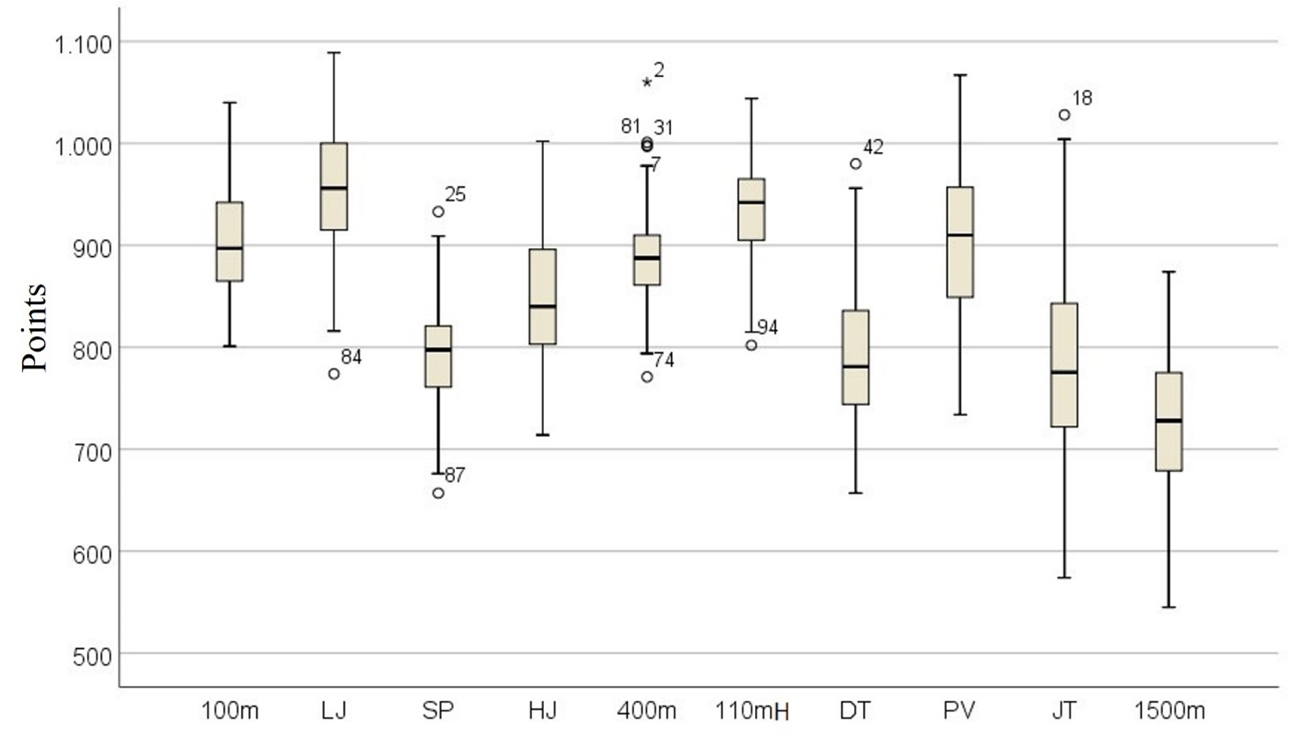
Figure 1
Boxplot which shows the scores according to event of the 102 athletes studied (world all-time)
Note. 100 meters (100m), Long Jump (LJ), Shot Put (SJ), High Jump (HJ), 400 meters (400m), 110 meters with Hurdles (110mH), Discus Throw (DT), Pole Vault (PV), Javelin Throw (JT) and 1500 meters (1500m).
Table 1 shows the descriptive statistics of the scores, points and relative weight (RW) of the 10 events that comprise the decathlon. It should be noted how the events that contribute the most points to the decathlon in this population are the long-jump (RW: 11.2% and 4 athletes with scores ≥8.00m), the 110m hurdles (RW: 11% and 2 athletes with scores ≤13.60 secs), pole-vault (RW: 10.6% and 1 athlete with scores ≥5.50m), and the 100m run (RW: 10.6% and 7 athletes with scores ≤10.35 secs). On the contrary, the events that were less valuable were the three throws (Shot put: 1 athlete with a score ≥17.00m; Discus: 1 athlete with a score ≥55.00m; Javelin: 2 athletes with scores ≥75m) and especially, the 1500m run (4 athletes with scores ≤4:15.00min).
Descriptive statistics (mean and standard deviation) of the 10 events of the decathlon. Each column shows the mean values of the scores, points and relative weight
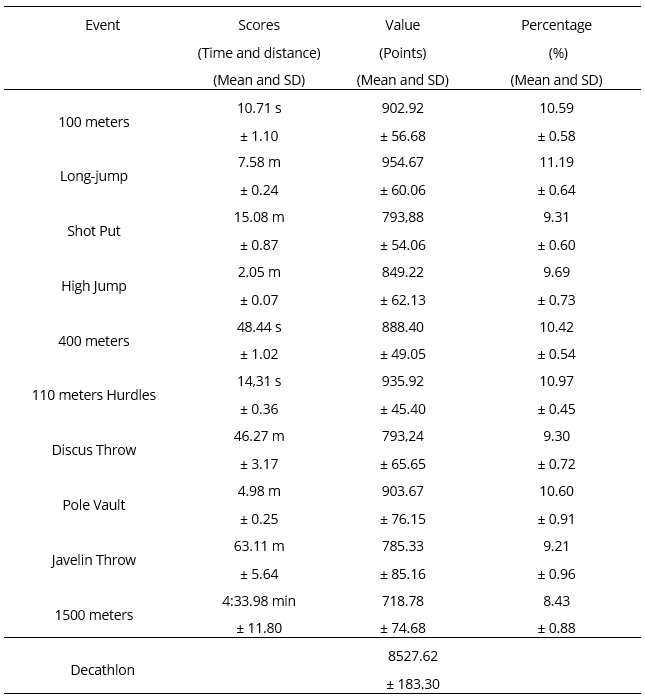
Normalized Similarity or Distance (Euclidean distance), between events (rounded values, without decimals)
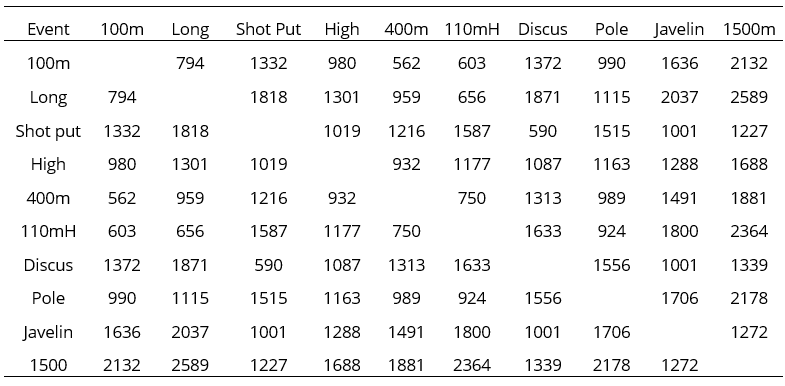
The coefficients of the similarity matrix (Table 2) indicates the distance between the 10 events. The greater the value, the greater the existing Euclidean distance, and as a result, the differences between both events will be greater and vice-versa. Based on this criteria, the greatest differences were found between the 1500m run and the 100m run (2133), long-jump (2589) and pole-vault (2178) events. Other events that showed clear differences with the rest of the events performed by a decathlete were the throws, especially the javelin throw. Javelin has important differences with the 110m hurdles (1800) and pole-vault (1706). On the contrary, the greatest similarities in these set of data were found between the 400m run and the 100m run (562) and the shot put and discus throw (590). Also important were the degrees of coincidence observed the 100m run and the 110m hurdles (603) and the long-jump (794).
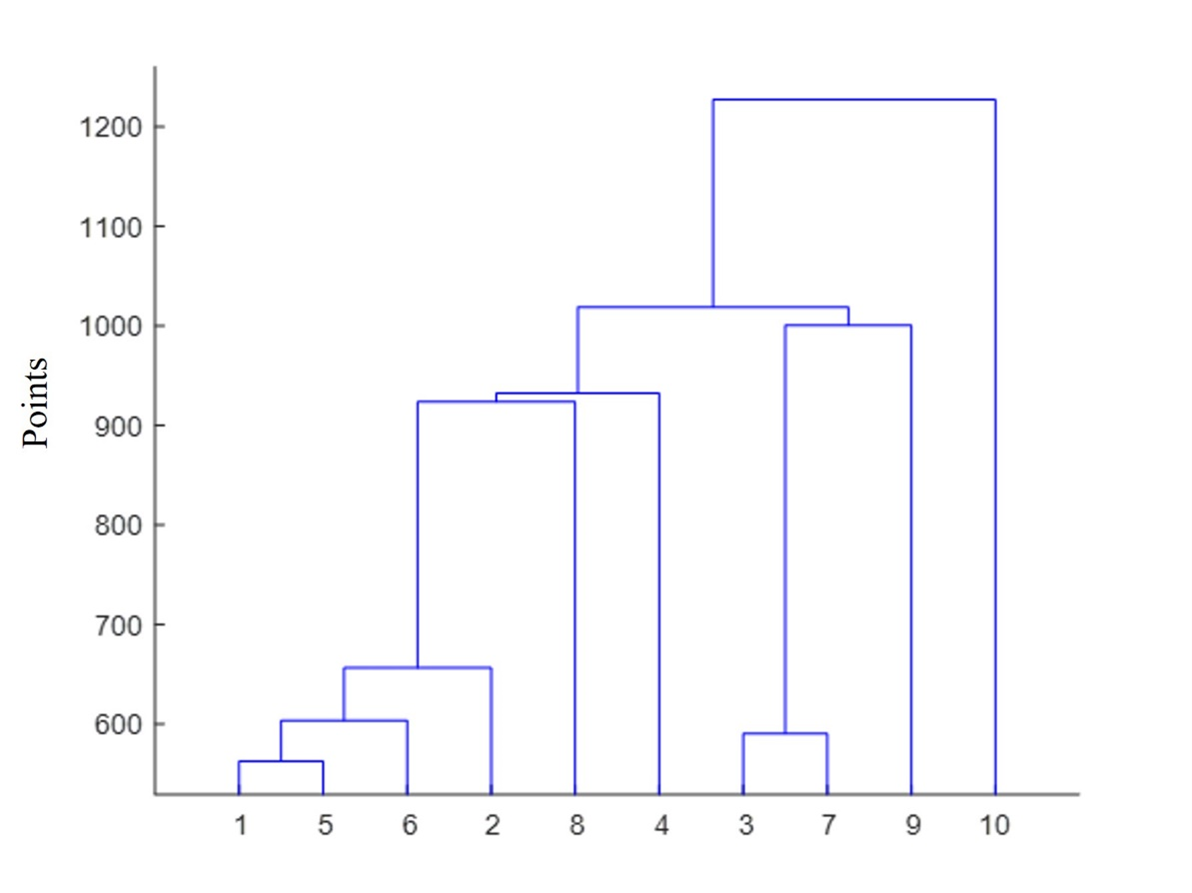
Figure 2
Hierarchal cluster (Dendogram) which shows the groups of events starting with the Points obtained with the IAAF Scoring Table
Note. 1=100m; 2=Long-jump; 3=Shot put; 4=High Jump; 5=400m; 6=110m Hurdles; 7=Discus Throw; 8=Pole Vault; 9=Javelin Throw; 10=1500m.
The clusters or groupings (Figure 2) were created using the final partition of four conglomerates or groups of events, which occurs at a degree of similarity slightly higher than 1000 points, and the 1500m run which shows a clearly differentiated profile to the rest of the disciplines. The first group (extreme left) is composed by the short runs (100m, 400m, 110m hurdles) and the long jump and pole-vault. The second conglomerate, to the right, is comprised by the high-jump. The third group is composed by the shot put and discus throws, and the fourth conglomerate, on the extreme right, by the javelin throw.
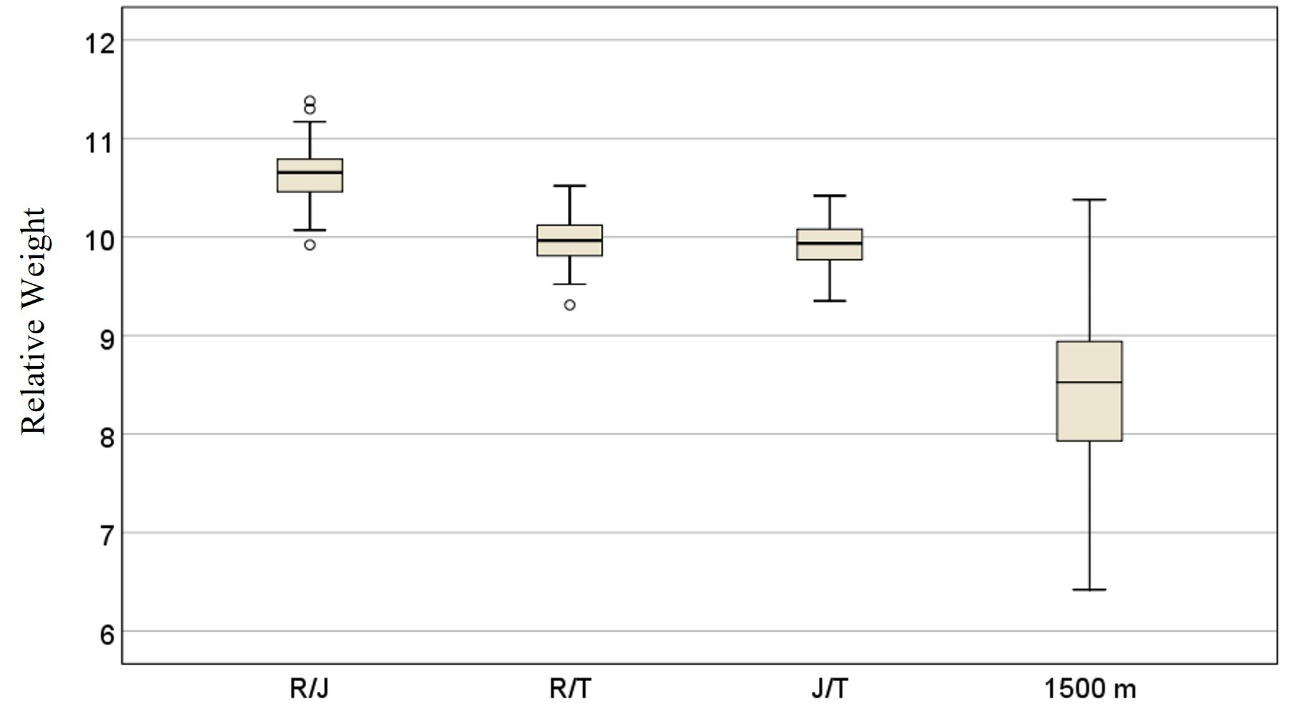
Figure 3
Relative Weight (RW) according to groups of events. Runners-Jumpers (R/J), Runners-Throwers (R/T), Jumpers-Throwers (J/T) and 1500-meter run
Figure 3 and Table 3 shows the groupings, according to their mean RW, of the decathletes defined as Runners (except for the 1500m run)-Jumpers (R/J), Runners-Throwers (R/T) and Jumpers-Throwers (J/T). In this case, it is observed how there is a clear weight of the events that are sustained on speed (10.62% ± 0.27%), while the other two groups show a similar weight (9.97% ± 0.22% and 9.93% ± 0.22%).
Statistical values (Mean, Median, Standard Deviation, Maximum and Minimum Values and Interquartile range -25/75) corresponding to the Mean Relative Weight (RW) of the events organized as Runners-Jumpers (R/J), Runners-Throwers (R/T), Jumpers-Throwers (J/T) and 1500-meter run
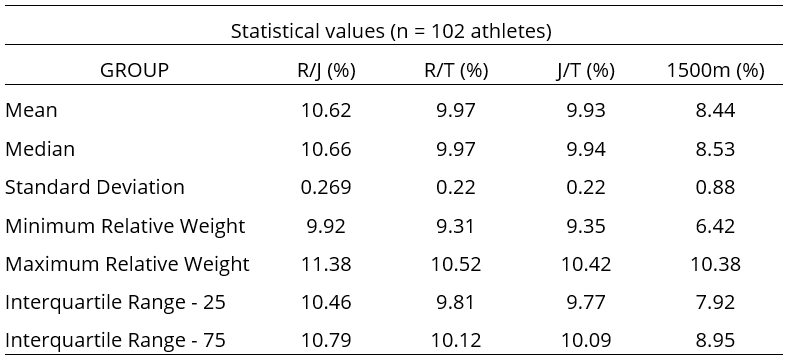
Discussion
The results obtained show, at least in our sample, that the use of cluster analysis allow us to precisely evaluate the characteristics of the athletes who participate at the highest level in decathlon. Likewise, it helps us to organize and classify the different athletic modalities that these athletes must perform, as well as to create groups of events as a function of the RW of each of them on the final score obtained by each decathlete. In the sample analyzed, it was discovered, in agreement with data from Broáni et al. (2020), that five groups of different events exist: G1: 100m, 400m, 110H, LJ and PV (PR= 53.8%); G2: HJ (PR= 9.7%); G3: SP and DT (PR=18.6%) G4: JT (PR=9.2%); G5. 1500m - PR=8.4%). Based on our results, the Top-Level decathletes could be mainly considered runner-jumper specialists (R/J: 10.62% ± 0.27) as compared to the decathletes who are runner-thrower type (R/T: 9.97% ± 0.22) or those who are jumper-thrower types (J/T: 9.93% ± 0.22).
In a similar research Pavlović (2017) proposed the existence of only three groups: a) the first group composed by four subgroups, comprised by the disciplines 100m, 110m, 400m, PV, LJ and HJ; b) a second group composed by disciplines including the three throwing events (SP, DT, JT) and the high-jump event (HJ); c) a third group which was defined by the only resistance-type run included in the decathlon (1500m). Re-enforcing this taxonomic proposal, but this time with the application of a Principal Component Analysis (PCA), Pavlović & Idrizović (2017) proposed for the sample, three different types of Top-Level decathletes at the international level. On this occasion, the authors indicated that the first type of decathlete included the ”jumper-thrower-runner” type specialists (PV, HJ, DT, SP and 400m), the second group included the “runner-sprinter” type specialists (100m and 110H), and the third group encompassed the decathletes who were ”jumper-thrower” type specialists. The different organization according to types of events had already been suggested by Woolf et al. (2007). These authors, after studying 173 Top-Level decathletes, proposed that at least from a physiological perspective, between three and five event cluster groups could be proposed: 5 groups: (100m, 400m, 110mH, LJ) - (SP DT JT) - (PV) - (HJ) -(1500m); 4 groups: (100m, 400m, 110H, LJ, PV) - ([SP, DT, JT)(HJ) - (1500m]; 3 groups: (100m, 400m, 110H, LJ, PV, HJ) - (SP, DT, JT) - (1500m). Previous to this, Kusnezow & Bakarinow (1973) differentiated two decathlete groups as a function of the events, on which they relied on to achieve their decathlon score, and the frequency with which these athletes reached the first places in the ranking. According to these authors, the most common athletes were those who were of universal types (all-rounders), the runners-jumpers, the runners and the jumpers, being less usual to find high-level specialists of the type of jumper-thrower, runner-thrower and throwers.
Being able to organize the athletes into event groups is a classical tool that has been utilized by researchers and coaches to study the decathlon, to establish the most adequate strategy during the competition and to plan the best training required by each athlete. Walker & Caddigan (2015) back the idea that the performance obtained in the 10 events allows establishing an objective criteria to discriminate between the “good” or ”bad” decathletes, as well as what type of specialist each athlete is. It should be taken into account that the disparity of events that each athlete must perform in the two days of the decathlon implies that the decathletes are specialists with a morphological (Kudu, 1989; Wang & Lu, 2007; Šolaja et al., 2017), bio-energetic (Beaulieu et al., 1995; Durand & Beaune, 2006) and physical (Ramadani et al., 2019) profile that is very characteristic and highly specialized (Tidow, 2001; Bilić, 2015; Bilić & Smajlović, 2015). Given that the specialization extols the universality of the athlete, and that the universality cannot be achieved with losses in the performance of some disciplines (Tidow, 2001), it is logical to think that searching, or achieving a similar performance in the ten events is highly complicated if not counter-productive.
With different nuances, all the studies including ours coincide in highlighting the weight of the short runs and the jumps as key events for obtaining an important score in the decathlon. Some authors (Woolf et al., 2007; Wimmer et al., 2011; Park & Zaciorski, 2011; Bilić, 2015; Pavlović et al., 2020), have suggested that the athletes who have their best performance in the running disciplines (except for the 1500m run) tend to have a greater advantage in the decathlon. In the study by Dziadek et al., (2018), where 25 Top-Level Polish decathletes were assessed (1985-2015 period) using a PCA, the first component would be comprised by the 100m run, the high jump and shot put (45.27%), the second component included the 400m run and the discus throw (14.49%) and the third component included the pole vault (10.01%). It should be taken into account that the runs with a high component of speed and the jumps have a greater weight on the score as compared to the throws and the rest of the events (Higgins, 1989; Tidow, 2000 a). Also, it should be taken into account that the starting speed is a key element for guaranteeing a good score in the 400m run (Zouhal et al., 2010), the 100m hurdles (Tsiokanos et al., 2018) and the LJ (Bridgett & Linthorne, 2006). These events are characterized for being highly dependent on anaerobic metabolism (alactic and lactic) and the fast development of force (especially the explosive-elastic-reflexive force) (Vittori, 1996). Nevertheless, in the hurdles, even though it is still a speed event, the technical mastery, and the adequate running rhythm between each of the obstacles are still key aspects for obtaining optimum results in the hurdles race. In this sense, some experts propose that the disciplines whose results depend more on the technical efficiency that the level of training of the basic motor abilities, are key proof of the success that an athlete could obtain in the decathlon (Bilić et al., 2015). This could be reason why the pole vault should be included in this group of events.
It is less frequent to highlight the RW that the throws have on the decathlon (Huang & He, 2013). The shot put and discus throw are events that are normally associated due to their similarity in the physical and metabolic dependence (Tidow, 2000 b; Cox & Dunn, 2002; Dziadek et al., 2017). A high relative weight of the throws would imply having available specialists who are heavier and taller (Chhina et al., 2017) and with a high ability to develop high levels of explosive force (Bazyler et al., 2017). In this sense, it is especially interesting to mention the work by Walaszczyk (1998 In Dziadek et al., 2018). The author, after analyzing the 50 best specialists during three successive Olympic cycles (1985-1996), found correlations of 0.59, 0.56 and 0.76 between the two events. However, there is a difference with the javelin throw. Wang (2017) found that the javelin throw, along with the high jump, pole vault and 1500 run, were events with a low relative weight on the final result.
In our study, although the 1500m run and the javelin throw had the least PR (8.43% and 9.21%, respectively), this is not what was found with the high jump and pole vault (9.69% ± 0.73 and 10.60% ± 0.91). At present, and in agreement with the current score tables, the shot put and the discus throw are the other two events with the least RW. Nevertheless, it should be pointed out that the study by Wang was conducted with the participants of the 12th National Games in China and the XXX Olympic Games in London-2012, meaning high-level athletes in a competition, while in our study, the best scores of the athletes with a personal score higher than 8300 points (Top-Level) were utilized.
The 1500m run deserves its own analysis. It is evident that the 1500m run has a completely different character as compared to the rest of the decathlon events (resistance vs speed/strength) (Vana, 2003; Dziadek et al., 2016; Dziadek et al., 2018). It is not common to find a Top-Level decathlete whose performance has a PR higher than 10% (Lee, 2010). In our study, it was observed that reaching a PR at that level would require the decathlete to run the 1500m in a time under 4’15’’. It should be taken into account that this is the last event in the decathlon, and the athletes arrive with a level of accumulated fatigue, especially neuro-muscular fatigue, which is highly important. According to Dziadek et al. (2016), the problem of how to address the 1500m run requires an individual focus, an analysis of the type of decathlete to which we refer to, and the evaluation about how the competition is evolving after the first nine events. It should be taken into account that the medium-distance runs, just as the 1500m run, are disciplines that demand the maximum power from the aerobic metabolism and the maximum power from the anaerobic metabolism (Billat et al., 2009), something that is not found in the rest of the events. Also, it should be taken into account that the specialists in the medium-distance runs are characterized for being athletes with thin extremities, long legs, low percentage of body fat, low weight and moderate strength Petrovic & Marinković, 2018), which implies possessing a biotype that is very different to that found for Top-Level decathletes (Šolaja et al., 2017). Likewise, it should be taken into account that resistance, as opposed to speed, requires a different composition of muscles (Van Damme et al., 2002). Resistance depends on a greater proportion of slow twitch (ST) muscles that are more resistant to fatigue (Myburgh, 2003), while the speed runners need a higher percentage of fast twitch (FT) muscle fibers (Korhonen et al., 2006).
Conclusions
The results of the present study demonstrate that there is a need to adequately combine the athletic potential of the specialist, prioritizing speed and explosiveness, without granting special attention to the 1500m run. Nevertheless, and in order to not find ourselves with an athlete who is excessively unbalanced, it is important to avoid excessively weak points, or failing that, promote them without negatively having an effect on the rest of the events. As a result, the combination of achieving average results in disciplines where the decathlete is weaker and achieving higher results that are preferably higher than the average in disciplines where the athlete stands out and is stronger, could be the most adequate strategy.
The analysis of the results obtained of the best all-time decathletes through a cluster analysis allow us to describe the heterogeneity of the results of the scores of the combined events to establish performance groups based on the RW of each event on the final result. The analysis shows that these specialists can be organized into 5 groups of different events. Based on these data, it was observed that they ideal type of Top-Level decathlete is that who stands out as having a runner-jumper profile, followed by the specialist with a runner-thrower profile. This analysis re-affirms the importance of the speed runs (100m, 400m and 110m hurdles) on the final result of a decathlon. The results contribute an important guide for the possible selection of talents in combined events, aside from contributing with efficient information for establishing an adequate strategy for the planning and monitoring of sports training taking into account the profile of the decathlete.
Bibliography
Bazyler, C. D., Mizuguchi, S., Harrison, A. P., Sato, K., Kavanaugh, A. A., DeWeese, B. H., & Stone, M. H. (2017). Changes in muscle architecture, explosive ability, and track and field throwing performance throughout a competitive season and after a taper. The Journal of Strength and Conditioning Research, 31(10), 2785-2793. doi:10.1519/JSC.0000000000001619
Beaulieu, P., Ottoz, H., Grange, C., Thomas, J., & Bensch, C. (1995). Blood lactate levels of decathletes during competition. British Journal of Sports Medicine, 29 (2): 80-84. doi: 10.1136/bjsm.29.2.80
Bilić, M, Smajlovic, N., & Balić, A. (2015). Contribution to discipline decathlon total score results in relation to decathlon age and result-level. Acta Kinesiologica, 9(1), 66-69.
Bilić, M. (2015). Determination of taxonomic type structures of top decathlon athletes. Acta Kinesiologica, 9(1), 20-23.
Bilić, M., & Smajlović, N. (2015). Real and hypothetical maximum potential scale ranges of most successful world decathlons. Acta Kinesiologica, 9, 2, 88‐91.
Billat, V., Hamard, L., Koralsztein, J. P., & Morton, R. H. (2009). Differential modeling of anaerobic and aerobic metabolism in the 800-m and 1,500-m run. Journal of Applied Physiology, 107(2), 478-487. doi:10.1152/japplphysiol.91296.2008
Bridgett, L. A., & Linthorne, N. P. (2006). Changes in long jump take-off technique with increasing run-up speed. Journal of Sports Sciences, 24(8), 889-897. doi:10.1080/02640410500298040
Broáni, J., Kováčová, N., Czaková, M. (2020). Klasifikácia atletického desaťboja prostredníctvom metód hierarchickej zhlukovej analýzy. In book: športa rekreácia, (pp.14-22). Publisher: KTVŠ PF UKF.
Chhina, S. S., Singh, K., & Kaur, R. (2017). Comparison of anthropometric measurements among the different groups of the throwers. European Journal of Physical Education and Sport Science, 3(12), 605-616. doi:10.5281/zenodo.1146894
Cox, T. F., & Dunn, R. T. (2002). An Analysis of Decathlon Data. Journal of the Royal Statistical Society. Series D (The Statistician), 51(2), 179–187. http://www.jstor.org/stable/3650318
Durand, S. & Beaune, B. (2006). Heart rate variation throughout the decathlon. Science & Sports, 21 (1): 32-35.
Dziadek, B., Iskra, J., & Przednowek, K. (2016). Running preparation and the final decathlon score in terms of sports career development. Physical Activity Review, 4, 115-123. doi:10.16926/par.2016.04.14
Dziadek, B., Iskra, J., & Przednowek, K. (2018). Principal Component Analysis in the Study of Structure of the Best Polish Decathlon Competitors from the Period between 1985–2015. Central European Journal of Sport Sciences and Medicine, 23, 77-87. doi:10.18276/cej.2018.3-08
Dziadek, B., Iskra, J., Pietrzak, M., & Przednowek, K. (2017). The role of throwing events in decathlon – Analysis of absolute and point results. 11th International Conference on Kinanthropology - Special section: Atletika 2017, At Brno, 1022-1031.
García-Roca, J.A., Paz, P. & Peñalver, A. (2021). Las pruebas combinadas. In García-Roca, J.A, Sánchez, A. & Hernández, M.C., Atletismo para Jóvenes. (pp. 165-175). Editorial INDE.
Higgins, A. (1989). Beyond Speed in the Decathlon. New Studies in Athletics, 2 : 39-44.
Huang, C., & He, Y. (2013). Grey Correlation Analysis of Decathlon Achievement of the World Elite Athletes Ashton James Eaton. International Workshop on Computer Science in Sports (IWCSS 2013). Published by Atlantis Press.
Jiménez-Reyes, P., & González-Badillo, J. J. (2011). Control de la carga de entrenamiento a través del CMJ en pruebas de velocidad y saltos para optimizar el rendimiento deportivo en atletismo. Cultura, Ciencia y Deporte, 6(18), 207-217. doi:10.12800/ccd.v6i18.48
Korhonen, M. T., Cristea, A., Alén, M., Hakkinen, K., Sipila, S., Mero, A., Viitassalo, J.T., Larsson, L., & Suominen, H. (2006). Aging, muscle fiber type, and contractile function in sprint-trained athletes. Journal of Applied Physiology, 101(3), 906-917. doi: 10.1152/japplphysiol.00299.2006
Kudu, F. O. (1989). Pruebas múltiples de atletismo. Ciudad de La Habana (Cuba). Editorial Científico Técnica. Ministerio de Cultura.
Kunz, H. (1989). Long term planning of combined event training. New Studies in Athletics, 2, 8-13.
Lee, J. T. (2010). A Study on the performance pattern in the elite decathlon. Journal of the Korean Data and Information Science Society, 21(6), 1071-1079.
Madruga Vicente, M., Cerro Herrero, D., Angosto Sánchez, S., & Prieto Prieto, J. (2021). Calidad percibida e intenciones futuras en eventos deportivos: segmentación de participantes de carreras por montaña. Cultura, Ciencia y Deporte, 16(50). doi:10.12800/ccd.v16i50.1584
Myburgh, K. H. (2003). What makes an endurance athlete world-class? Not simply a physiological conundrum. Comparative Biochemistry and Physiology Part A: Molecular & Integrative Physiology, 136(1), 171-190. doi:10.1016/S1095-6433(03)00220-4
Park, J., & Zatsiorsky, V.M. (2011). Multivariate statistical analysis of decathlon performance results in Olympic athletes (1988–2008). World Academy of Science, Engineering and Technology, International Journal of Social, Behavioral, Educational, Economic, Business and Industrial Engineering, 5, 985-988. doi:10.5281/zenodo.1334870
Pavlović, R, Idrizović K. (2017). Factor analysis of world record holders in athletic decathlon. Sport Science, 10(1): 109-116.
Pavlović, R. (2017). Discipline homogeneity based on the most successful decathlon scoring placement. Turk Journal of Kinesiology, 3(1), 6-11.
Pavlović, R., Mensur, V., Petrović, B. (2020). Athletic decathlon: are there differences between the results of decathlon record-holders and their best personal results? Journal of Physical Education Research, 7(II) : 18-26.
Petrovic, I., & Marinković, M. (2018). Influence of morphological characteristics on running performance of endurance athletes. Facta Universitatis, Series: Physical Education and Sport, 16(1), 95-106. doi:10.22190/FUPES171231009P
Pulido, J., Sánchez-Oliva, D., Sánchez-Miguel, P., Leo, F., & García-Calvo, T. (2016). Influencia de la formación de los entrenadores sobre la motivación de los deportistas / Influence of Coaches Training on Athletes Motivation. Revista Internacional de Medicina y Ciencias de la Actividad Física y del deporte, (64). doi:10.15366/rimcafd2016.64.005
Ramadani, L., Heta, G., Bekolli, L., Rashiti, N., Ramabaja, Q., & Millaku, A. (2019). The impact of short run distances to the final results of the decathlon at the 2019 Athletic World Championships. Journal of Education, Health and Sport, 9(12), 101-109. doi:10.12775/JEHS.2019.09.12.011.
Šolaja, A., Milankov, A., Pejaković, S., & Stokić, E. (2017). Body composition of the Serbian national track and field team. Medicinski Pregled, 70(3-4), 87-94. doi:10.2298/MPNS1704087S
Tidow, G. (2000 a). Challenge Decathlon - Barriers on the way to becoming the “King of Athletes” (Part I). New Studies in Athletics. 15(3/2), 39-44.
Tidow, G. (2000 b). Challenge Decathlon - Barriers on the way to becoming the “King of Athletes” (Part II). New Studies in Athletics. 15(2), 43–53.
Tidow, G. (2001). Challenge Decathlon - Barriers on the way to becoming the “King of Athletes” (Part III). New Studies in Athletics. 16(1/2), 83-90.
Trkal, V. (2003). The development of combined events scoring tables and implications for the training of decathletes. New Studies in Athletics, 18(4), 7-14.
Tsiokanos, A., Tsaopoulos, D., Giavroglou, A., & Tsarouchas, E. (2018). Race pattern of Men's 110-M Hurdles: Time analysis of Olympic Hurdle performance. Biology of Exercise, 14(2), 14 (2), 15-36. doi:10.4127/jbe.2018.0136
Van Damme, R., Wilson, R., Vanhooydonck, B., & Peter Aerts. (2002). Performance constraints in decathletes. Nature, 415, 755–756. doi:10.1038/415755b
Vana, Z. (2003). The training of the best decathletes. New Studies in Athletics, 4, 15-30.
Vittori, C. (1996). The European school in sprint training: The experiences in Italy. New Studies in Athletics, 11, 85-92.
Walaszczyk, A. (1998). Wybrane uwarunkowania osobnicze osiągnięć sportowych kobiet i mężczyzn w wielobojach lekkoatletycznych. Katowice: AWF Katowice. En Dziadek et al. (2018). Principal Component Analysis in the Study of Structure of the Best Polish Decathlon Competitors from the Period between 1985–2015. Journal of Sports Science and Medicine, 23, 77-87.
Walker, J. A., & Caddigan, S. P. (2015). Performance trade-offs and individual quality in decathletes. Journal of Experimental Biology, 218(22), 3647-3657. doi:10.1242/jeb.123380
Wang, Z. (2017). Men’s decathlon high level athlete’s performance characteristics. In 2016 National Convention on Sports Science of China (p. 01032). EDP Sciences. doi:10.1051/ncssc/201701032
Westera, W. (2006). Decathlon: Towards a balanced and sustainable performance assessment method. New Studies in Athletics, 21(1):39–51.
Wimmer, V., Fenske, N., Pyrka, P., & Fahrmeir, L. (2011). Exploring Competition Performance in Decathlon Using Semi-Parametric Latent Variable Models. Journal of Quantitative Analysis in Sports, 7(4), 1-19. doi:10.2202/1559-0410.1307
Woolf, A., Ansley, L., & Bidgood, P. (2007). Grouping of decathlon disciplines. Journal of Quantitative Analysis in Sports, 3(4), 5. doi:10.2202/1559-0410.1057
Zouhal, H., Jabbour, G., Jacob, C., Duvigneau, D., Botcazou, M., Abderrahaman, A. B., Prioux, J., & Moussa, E. (2010). Anaerobic and aerobic energy system contribution to 400-m flat and 400-m hurdles track running. The Journal of Strength and Conditioning Research, 24(9), 2309-2315. doi:10.1519/JSC.0b013e3181e31287
Author notes
* Correspondence: Juan Alfonso García-Roca, jagarcia@ucam.edu
Additional information
Short title: Performance analysis in high-level decathletes
How to cite this article: García-Roca, J.A., García-Manso, J.M., Fuentes-García, J.P., Martínez Patiño, M.J. (2022). Performance analysis of the events groups as a predictor of high-level decathletes. Cultura, Ciencia y Deporte, 17(52), 179-187. http://doi.org/10.12800/ccd.v17i52.1789

ISSN: 1696-5043
Vol. 17
Num. 52
Año. 2022
Performance analysis of the events groups as a predictor of high-level decathletes
Juan AlfonsoJuan ManuelJuan PedroMaría José García-RocaGarcía-MansoFuentes-GarcíaMartínez Patiño
Universidad Católica de MurciaUniversidad de las Palmas de Gran CanariaUniversidad de ExtremaduraUniversidad de Vigo,EspañaEspañaEspañaEspaña


